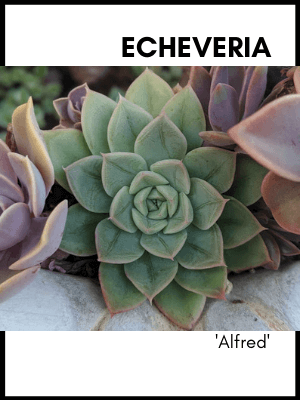
Growing Season:
Summer
Dormant Season:
Winter
-
Hardy to USDA Zone: 10a
- Size: Up to 6″ wide
- Foliage: Green, light green glaucous
- Flower: Yellow
-
Propagation: Stem cuttings, leaves, seed, offsets
-
Light: Full sun, bright shade
-
Water: Drench & Dry
-
Soil: Gritty, mostly inorganic, quickly draining
- Origin: Unknown
About Echeveria ‘Alfred’
Echeveria ‘Alfred’ is known in Korea by the name Echeveria ‘Moon Fairy’ so you might have more luck finding one by that name. I had no idea it was rare, but apparently it is and I have one!
Echeveria ‘Alfred’ has light green, glaucous leaves with an indentation down the middle of the leaves which gives the rosette a really neat spiral effect when you take a step back and look at it from a distance.
The parentage of Echeveria ‘Alfred’ is hybrid of E. elegans and E. pulidonis which totally makes sense to me. I can see both parents in this rare hybrid!
As with all other Echeveria species, Echeveria ‘Alfred’ or ‘Moon Fairy’ is one succulent that loves lots of light. If acclimated properly, it can handle full sun and will keep its compact rosette shape.
